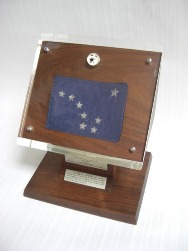You might think we’re trying to sell you the moon with this next story…
A long lost piece of moon rock, given to the State of Alaska by President Richard Nixon more than 40 years ago, is now the subject of a legal battle between the state and a former resident turned Deadliest Catch boat captain, who claims to have found it when he was a teenager.
Casey Kelly has more on this truly bizarre tale.

From 1969 through 1972, NASA’s six Apollo missions returned to Earth with hundreds of pounds of moon dust. The Nixon White House mounted samples of the dust onto plaques and called them Goodwill Moon Rocks – given to all 50 states, hundreds of countries, and a few individuals. The moon rock Alaska received from the 1969 Apollo 11 mission ended up at the State Museum in Juneau, which loaned it out to other facilities until it went missing in the early ‘70s.
“I kinda figured we’re never going to find this moon rock,” says Elizabeth Riker, a University of Phoenix criminal justice graduate student from Detroit. As part of a class assignment she began investigating Alaska’s missing lunar fragments. Last August she wrote about it for the Capital City Weekly.
“I got quite a few emails from citizens in Alaska, asking me questions and saying they remember seeing the moon rock when they were in elementary school,” says Riker. “But obviously they all said this was back, late ‘60s, 1970, that time frame. But nobody had seen it since.”
So, what do moon rocks have to do with criminal justice? Riker’s professor, Joe Gutheinz is a retired Senior Special Agent with NASA’s Office of Inspector General.
“I would conduct criminal investigations and civil investigations impacting NASA,” says Gutheinz. “And in 1998, I went undercover in Operation Lunar Eclipse to recover the Honduras Goodwill Moon Rock.”
Gutheinz says there’s no shortage of missing moon rocks, so the investigation assignment is one he commonly gives to his students.
“About 160 moon rocks are missing that were given to the nations of the world,” he says. “And we’ve also determined that 18 Apollo 11 moon rocks given to the states and nine Apollo 17 Goodwill Moon Rocks given to the states are also missing. Lost, destroyed, or stolen.”
In December, a man named Coleman Anderson filed a lawsuit against the state seeking clear title to Alaska’s Apollo 11 moon rock. Anderson claims his step father was the curator of the State Transportation Museum in Anchorage when it was destroyed by arson in 1973. In the days after the fire, Anderson – 17 at the time – says he found the moon rock in a trash heap. Daniel Harris is Anderson’s Seattle-based attorney.
“The curator of the museum, basically signed off on him taking them,” Harris says. “And they sat in Coleman’s basement or wherever for about 30 years and then he read about somebody having sold moon rocks and he said, ‘Boy, maybe I have something of value here.'”
According to Harris, Anderson currently resides somewhere in the southern United States and hasn’t lived in Alaska for several years. But he was the captain of a Bering Sea crab vessel – even appearing in season one of the reality show Deadliest Catch.
On the black market moon rocks have been known to go for millions of dollars. So, if Anderson is awarded ownership, he could sell the Alaska rock for quite a bit of money. But Harris says his client is interested in cutting a deal with the state.
“We’re very open to ideas as to how a compromise could be reached,” Harris says.
The moon rock Anderson claims as his hasn’t been authenticated. Nevertheless, the state has filed a counterclaim against him charging that he trespassed and assumed ownership of state property without permission. In addition, the state is seeking return of the moon rock and its plaque, and damages for the years in which residents lost use of them. Bob Banghart is chief curator of the Alaska State Museum.
“I think that would be appropriate, if it turns out to be the real thing,” Banghart says of having Anderson return the moon rock. “It would be part of the mission for us. We don’t like to lose things, no matter how it occurs.”
Retired Special Agent Joe Gutheinz – now an attorney in private practice – agrees.
“And I’m not talking about the law. I’m talking about morality here,” Gutheinz says. “And my opinion: That moon rock was given to the children of Alaska.”
Remember that Honduras moon rock Gutheinz recovered in 1998? It was the subject of a 5-year court battle before a judge ordered it to be returned to the US government, which gave it back to Honduras. Whether Alaska gets its moon rock back remains to be seen.
